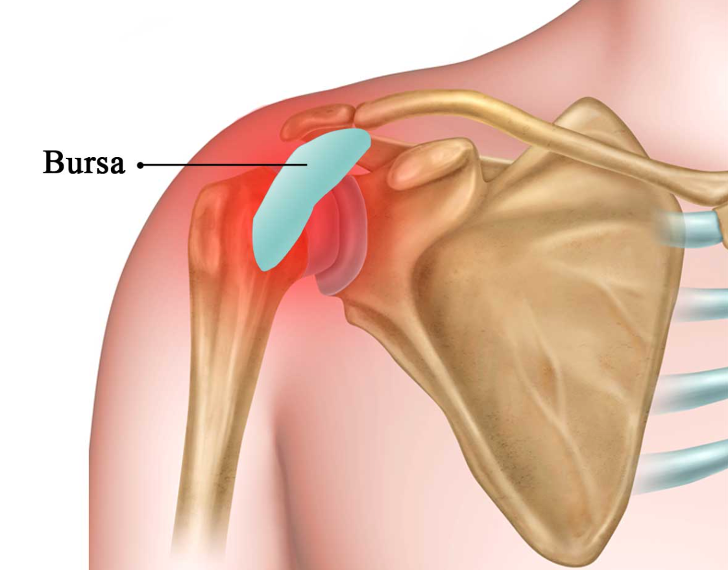Bursa inflammation is known as bursitis. A closed, liquid-filled sac called a bursa serves as a cushion and gliding surface to lessen friction between human tissues. The primary bursae are located close to major joints like the shoulders, elbows, hips, and knees, situated alongside the tendons.
Bursitis often only lasts a short time. It may limit movement but usually doesn’t cause physical distortions.
Bursitis can occur in any bursal sac throughout the body, yet several typical forms of bursitis exist, such as:
- Retro malleolar tendon bursitis
- Posterior Achilles tendon bursitis
- Hip bursitis
- Elbow bursitis
- Knee bursitis
- Kneecap bursitis

Overview
What is Shoulder Bursitis?
Bursitis refers to the inflammation of a bursa, a small sac-like structure found in areas prone to friction, such as between skin and bones, tendons and bones, or ligaments and bones. This condition typically presents with pain and occasionally with redness and swelling. Bursae, being extremely thin sacs consisting of only a few cells, act as cushions to reduce friction between hard bones and softer tissues. An apt comparison would be like rubbing leather against a table’s edge, gradually causing wear. Similarly, without bursae, repeated friction would lead to the wearing out of skin, tendons, and ligaments against bony surfaces. The body hosts over 150 bursae strategically located wherever friction is a possibility.
What types of shoulder bursitis are there?
There are several types of shoulder bursitis:
- Chronic: This form develops gradually due to repeated injuries or recurrent episodes of acute bursitis. It’s the most prevalent type, characterized by periods of symptom remission followed by flare-ups lasting several months. Persistent inflammation over time can lead to weakness in the arm and shoulder. Individuals often adapt to the pain, potentially resulting in additional regional discomfort, such as in other areas of the shoulder, neck, or elbow.
- Acute: This type manifests suddenly, typically stemming from an accident or injury. Movement or contact with the shoulder triggers sharp pain.
- Infectious (septic): In rare instances, bacterial infections like staph infections can cause infectious shoulder bursitis. The affected shoulder may appear red or purple and feel warm to the touch. Fever and general malaise may accompany severe shoulder pain in these cases.
Symptoms & Causes
What are the symptoms of shoulder bursitis?
Shoulder bursitis typically involves discomfort and pain due to the inflammation of the bursa, which acts as a cushion for a tendon in the rotator cuff connecting bones. The severity of pain can vary depending on the individual’s injury, but common symptoms include:
- Discomfort experienced when lying on the affected shoulder.
- Pain felt on the outer or upper part of the shoulder.
- Increased pain when raising the arm sideways.
- Pain while exerting force to push or pull, such as opening a door.
- Difficulty performing circular motions with the arm.
- Feeling pressure and pain when pressing on the top of the shoulder.
Certain groups, such as carpenters, musicians, athletes, and gardeners, who frequently use their shoulders, are at a higher risk of developing shoulder bursitis. However, it’s essential to note that anyone can injure their shoulder and develop bursitis.
What is the cause of shoulder bursitis?
While bursitis can occur in any joint, it frequently affects the shoulder. Overuse or repetitive movements of the shoulder commonly cause shoulder bursitis.
Engaging in overhead activities heightens the friction between bones and surrounding tissues. This continued friction can lead to inflammation and irritation of the bursae. The accumulation of fluid in the bursa sacs results in the development of bursitis.
Risks of shoulder Impingement
Certain medical conditions can either cause shoulder bursitis or increase one’s susceptibility to it. These conditions include: 
- Rheumatoid arthritis,
- Diabetes, and
- Gout.
- Kidney disease or uremia (accumulation of waste in the blood)
- Thyroid disorder
What other ailments lead to shoulder discomfort?
Individuals experiencing shoulder bursitis often also suffer from shoulder tendinitis, which involves damage to the tendons of the rotator cuff. Both conditions result in shoulder pain, inflammation, and stiffness.
Moreover, the following conditions can impact shoulder mobility and induce shoulder pain:
- Bone spurs or calcific tendinitis.
- Shoulder dislocation.
- Frozen shoulder.
- Osteoarthritis.
- Rotator cuff tears.
- Shoulder impingement syndrome.
Diagnosis of Bursitis:
When assessing shoulder bursitis, a physician may inquire about various risk factors, such as medical history, occupation, and recreational activities.
Diagnostic procedures may involve:
- Physical examinations: By assessing the location of pain, muscle strength, and the range of motion in the shoulder joint, a doctor can often diagnose bursitis.
- Radiography: Although X-rays do not directly visualize the bursa, they can help rule out bone damage or arthritis as potential causes of shoulder pain. This step is crucial in determining the appropriate treatment approach.
- MRI scans: While not always necessary for diagnosis, MRI scans can reveal inflammation in the bursa or any damage to surrounding bone and tissue.
- Fluid analysis: Aspiring fluid from the bursa allows for testing to rule out infection, a process known as fluid testing.
Bursitis Treatment:
Home Treatment:
Since bursitis often stems from inflammation, allowing your shoulder adequate rest can often alleviate symptoms. Here are some home remedies that can help reduce bursitis symptoms:
- Rest your shoulder.
- Take an over-the-counter pain reliever: Nonsteroidal anti-inflammatory drugs (NSAIDs) like ibuprofen (Advil, Motrin) or naproxen sodium (Aleve) are particularly effective in reducing inflammation. Acetaminophen (Tylenol) may also help alleviate pain.
- Use an ice pack for 10 to 15 minutes.
- Use a shoulder brace for support.
- Engage in gentle stretching exercises, but avoid overexertion or pushing to the point of extreme pain or discomfort.
The non-surgical options for treating shoulder bursitis
The focus of treatment for shoulder bursitis is on reducing inflammation and alleviating symptoms. Most individuals experience relief from symptoms through these non-surgical methods:
- Bursa injections (steroids) to alleviate pain and swelling for a period of a few months.
- Oral corticosteroids like Kenalog or Celestone for severe pain and inflammation.
- Physical therapy exercises aimed at strengthening weak muscles and enhancing range of motion.
- Antibiotics to treat bacterial infections contributing to bursitis.
Surgical options for shoulder bursitis:
If symptoms worsen or fail to improve with non-surgical methods, your healthcare provider might suggest surgery. This procedure may be performed arthroscopically, utilizing small incisions and a miniature camera (arthroscope).
During the surgery, your provider may:
- Remove damaged tissue that is compressing and irritating the bursae.
- Excise inflamed bursae to create space for the tendons and bones to move freely.
Prevention:
The primary focus in preventing shoulder bursitis is minimizing strain on the shoulder joint. Employing the following prevention tactics can be beneficial:
- Prior to exercising or engaging in repetitive shoulder movements, warm up and stretch the shoulder.
- Strengthen the shoulder muscles through gentle exercises.
- Gradually increase intensity when starting any new activity that stresses the shoulder.
- Take regular breaks when utilizing the shoulder repetitively.
- Enhance posture to maintain shoulder muscle engagement and alleviate joint pressure.
When to seek medical attention for shoulder bursitis?
It’s advisable to schedule a consultation with your doctor if you experience any of the following:
- Severe joint pain that significantly impairs movement.
- Sudden inability to move a joint.
- Excessive swelling, redness, bruising, or a rash in the affected area.
- Sharp or shooting pain, particularly during physical activity or exertion.
- Presence of fever.
Complications:
What are the potential complications of shoulder bursitis?
Persistent shoulder bursitis and recurrent flare-ups have the potential to harm the bursae, leading to a reduction in shoulder mobility over time.
In cases of infectious (septic) shoulder bursitis, the bacteria responsible can spread to other organs and body parts. In severe instances, this can result in sepsis, a potentially life-threatening condition.
